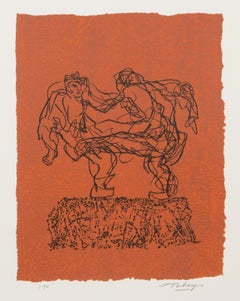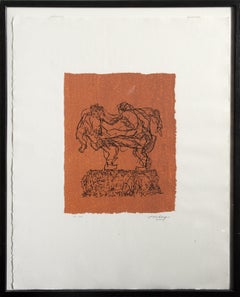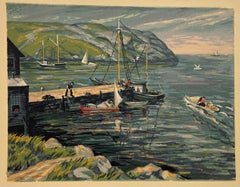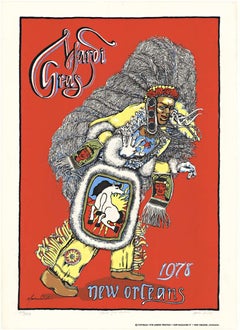Mark Tobey Figurative Prints
American, 1890-1976
Mark George Tobey (December 11, 1890 – April 24, 1976) was an American painter. His densely structured compositions, inspired by Asian calligraphy, resemble Abstract expressionism, although the motives for his compositions differ philosophically from most Abstract Expressionist painters.to
2
3
Overall Width
to
Overall Height
to
2
2
46
846
382
380
308
5
5
5
3
2
1
1
1
3
2
1
1
5
Artist: Mark Tobey
Ritual Mark Tobey abstract black tan and white lithograph
By Mark Tobey
Located in New York, NY
This delicate composition in black and tan features layers of sheer brushwork, inky daubs, and thin lines. Mark Tobey, one of the founders of the American Mystical school of painting...
Category
1970s Abstract Mark Tobey Figurative Prints
Materials
Lithograph
Dialogue Between Ancients Mark Tobey black and white greek roman philosophers
By Mark Tobey
Located in New York, NY
This portrait of two philosophers in conversation is a rare figurative work from Mark Tobey, one of the founders of the American Mystical school of pa...
Category
1970s Mark Tobey Figurative Prints
Materials
Lithograph
Clarté I Mark Tobey abstract green turquoise and black lithograph
By Mark Tobey
Located in New York, NY
Clarté by Mark Tobey is a characteristically delicate, abstract composition of swirling green and black curls. The gentle movement of his mark-making suggests a natural form such as ...
Category
1970s Abstract Mark Tobey Figurative Prints
Materials
Lithograph
Folk Dance on Independence Day, Modern Screenprint by Mark Tobey
By Mark Tobey
Located in Long Island City, NY
Mark Tobey, American (1890 - 1976) - Folk Dance on Independence Day, Year: 1972, Medium: Screenprint on Richard de Bas, signed and numbered in pencil, Edition: 175, Image Size: 13....
Category
1970s Modern Mark Tobey Figurative Prints
Materials
Screen
Folk Dance on Independence Day, Modern Screenprint by Mark Tobey
By Mark Tobey
Located in Long Island City, NY
Mark Tobey, American (1890 - 1976) - Folk Dance on Independence Day, Year: 1972, Medium: Screenprint on laid Richard de Bas, signed and numbered in pencil, Edition: 35/175, Image S...
Category
1970s Modern Mark Tobey Figurative Prints
Materials
Screen
Related Items
Harry Shokler, Island Harbor
By Harry Shokler
Located in New York, NY
Harry Shokler used serigraphy to great advantage in this landscape. It's colorful and detailed.
It is signed in the image at the lower left. When printmakers began making serigraphs...
Category
1940s American Modern Mark Tobey Figurative Prints
Materials
Screen
Original Mardi Gras New Orleans 1978 festival serigraph poster
Located in Spokane, WA
Original Mardi Gras, New Orleans, 1978 linen-backed poster. Dressed up in what would be an American Indian costume with full headgear, he is holding a shield with a horse on it. Indian decoration on the footwear. Signed and numbered.
I believe this has to deal with Big Chief leading his Congo Nation Mardi Gras Indian group. Zulu Parade. Many of the original Mardi Gras jazz posters...
Category
1970s American Modern Mark Tobey Figurative Prints
Materials
Screen
$636 Sale Price
20% Off
H 32 in W 23 in D 0.05 in
Mother And Child
By Romare Bearden
Located in New York, NY
Color screenprint on paper. Signed by the artist in pencil, lower right. Numbered 71/200 in pencil, lower left.
Catalogue raisonne refernece: Gelburd/Rosenberg 59.
Framed d...
Category
1970s Modern Mark Tobey Figurative Prints
Materials
Screen, Color
Ballerine sur fond vert, 1995, original lithograph by Jean Jansem, handsigned
By Jean Jansem
Located in Les Acacias GE, GE
Jean Jansem (1920-2013)
Ballerine sur fond vert, 1995
Lithographie sur papier Arches, justifiée et numérotée 48/100
Signée en bas à droite
22 x 17 cm / 32 x 26 cm
Bibliographie:
...
Category
Late 20th Century Expressionist Mark Tobey Figurative Prints
Materials
Lithograph
$358 Sale Price
20% Off
H 12.6 in W 10.24 in
Cup 2 Picasso (Sparks 113; Field 168; ULAE 123), Jasper Johns
By Jasper Johns
Located in Fairfield, CT
Artist: Jasper Johns (1930)
Title: Cup 2 Picasso (Sparks 113; Field 168; ULAE 123)
Year: 1973
Medium: Color lithograph on wove paper
Edition: 1,500
Size: 14 x 10.5 inches
Inscription: Signed & dated with the artist's plate-signed signature.
Condition: Excellent
Notes: This image, as well as a companion print Cups 4 Picasso, is based on Marcel Duchamp’s 1958 collage Self-Portrait in Profile. Printed by Bill Goldston and James V...
Category
1970s Abstract Expressionist Mark Tobey Figurative Prints
Materials
Lithograph
$556 Sale Price
20% Off
H 14 in W 10.5 in
Valerio Adami Italian Artist 1976 Original Poster lithograph Galerie Maeght
By Valerio Adami
Located in Miami, FL
"Valerio Adami (Italy, 1935)
'Moments musicaux de six a huit', 1976
Original poster from 1976
lithograph on paper
26 x 18.2 in. (66 x 46 cm.)
Unframed
Ref: ADA100-202
Valerio Adami
...
Category
1970s Abstract Mark Tobey Figurative Prints
Materials
Lithograph
$250
H 25.99 in W 18.12 in
Devil
By Alexander Calder
Located in Washington, DC
Artist: Alexander Calder
Title: Devil
Medium: Etching and aquatint in colors
Date: 1974
Edition: 20/80
Sheet Size: 25 7/8" x 20"
Image Size: 19 1/8" x 13 1/2"
Signature: Hand signed ...
Category
1970s Abstract Mark Tobey Figurative Prints
Materials
Lithograph, Aquatint
The Boundaries Of Our Realities Are Set By The Limits Of Our Imagination
By The Connor Brothers
Located in New York, NY
A pristine color screenprint, acrylic and oil paint and varnish over giclée on paper. Signed and dated in white ink by the Connor Brothers. Dimensions with the frame are 32 x 22 inches.
Category
2010s Modern Mark Tobey Figurative Prints
Materials
Paper, Varnish, Oil, Acrylic, Color, Giclée, Screen
$6,000
H 29.25 in W 19.5 in
Le Clairon, 1993, original lithograph by Jean Jansem, handsigned and numbered
By Jean Jansem
Located in Les Acacias GE, GE
Jean Jansem (1920-2013)
Le Clairon, 1993
Lithographie sur papier Arches, justifiée EA12/30
Signée en bas à droite
65 x 50 cm / 76 x 56 cm
Bibliographie:
CR Jansem, 2000, n°85
"Ma...
Category
Late 20th Century Expressionist Mark Tobey Figurative Prints
Materials
Lithograph
$944
H 29.93 in W 21.26 in
Puppet Man, E. A
By Alexander Calder
Located in Miami Beach, FL
"Puppet Man, 1960. By Alexander Calder.
"E.A" Written in pencil by the artist
The "E.A." designation on the print likely indicates it's an artist's proof, o...
Category
1960s Abstract Geometric Mark Tobey Figurative Prints
Materials
Archival Paper, Lithograph
Pixies — Original 2004 Serigraph by Emek — Hand-Signed by All Four Band Members
Located in Spokane, WA
Pixies — Original 2004 Greek Theatre LA Serigraph by Emek — Hand-Signed by All Four Members — Rare. Signed by the artist Emek as well.
Capture a key moment in alt-rock history with...
Category
Early 2000s Modern Mark Tobey Figurative Prints
Materials
Screen
$900
H 28.5 in W 24 in D 0.3 in
Sophie aux bas rouges, 1993, original lithograph by Jean Jansem
By Jean Jansem
Located in Les Acacias GE, GE
Jean Jansem (1920-2013)
Sophie aux bas rouges, 1993
Lithographie sur papier Arches, justifiée E/A
Signée en bas à droite
66 x 50 cm / 76 x 56 cm
Bibliographie:
CR Jansem, 2000, n°...
Category
Late 20th Century Expressionist Mark Tobey Figurative Prints
Materials
Lithograph
$1,297
H 29.93 in W 22.05 in
Previously Available Items
Ritual Mark Tobey abstract black tan and white lithograph
By Mark Tobey
Located in New York, NY
This delicate composition in black and tan features layers of sheer brushwork, inky daubs, and thin lines. Mark Tobey, one of the founders of the American Mystical school of painting...
Category
1970s Abstract Mark Tobey Figurative Prints
Materials
Lithograph
Clarté I Mark Tobey abstract green turquoise and black lithograph
By Mark Tobey
Located in New York, NY
Clarté by Mark Tobey is a characteristically delicate, abstract composition of swirling green and black curls. The gentle movement of his mark-making suggests a natural form such as ...
Category
1970s Abstract Mark Tobey Figurative Prints
Materials
Lithograph
Ritual Mark Tobey abstract black tan and white lithograph
By Mark Tobey
Located in New York, NY
This delicate composition in black and tan features layers of sheer brushwork, inky daubs, and thin lines. Mark Tobey, one of the founders of the American Mystical school of painting...
Category
1970s Abstract Mark Tobey Figurative Prints
Materials
Lithograph
Original etching "Companionship" by Mark Tobey, 1974
By Mark Tobey
Located in Hinsdale, IL
Tobey, Mark
(American, 1890-1976)
"Companionship"
Etching with aquatint in colors on paper, 1974
Signed and numbered in pencil in lower margin
Number 88 ...
Category
1970s Abstract Expressionist Mark Tobey Figurative Prints
Materials
Etching
Psaltery, 2nd Form
By Mark Tobey
Located in Long Island City, NY
Artist: Mark Tobey, American (1890 - 1976)
Title: Psaltery, 2nd Form
Year: 1974
Medium: Etching on Japon, signed and numbered in pencil
Edition: L (50), EA XX
Paper Size: 26.5 x 20 i...
Category
1970s Abstract Expressionist Mark Tobey Figurative Prints
Materials
Etching
Mark Tobey figurative prints for sale on 1stDibs.
Find a wide variety of authentic Mark Tobey figurative prints available for sale on 1stDibs. You can also browse by medium to find art by Mark Tobey in lithograph and more. Much of the original work by this artist or collective was created during the 1970s and is mostly associated with the abstract style. Not every interior allows for large Mark Tobey figurative prints, so small editions measuring 15 inches across are available. Customers who are interested in this artist might also find the work of Jean-Paul Riopelle, George Stauch, and Robert Motherwell. Mark Tobey figurative prints prices can differ depending upon medium, time period and other attributes. On 1stDibs, the price for these items starts at $450 and tops out at $900, while the average work can sell for $900.



